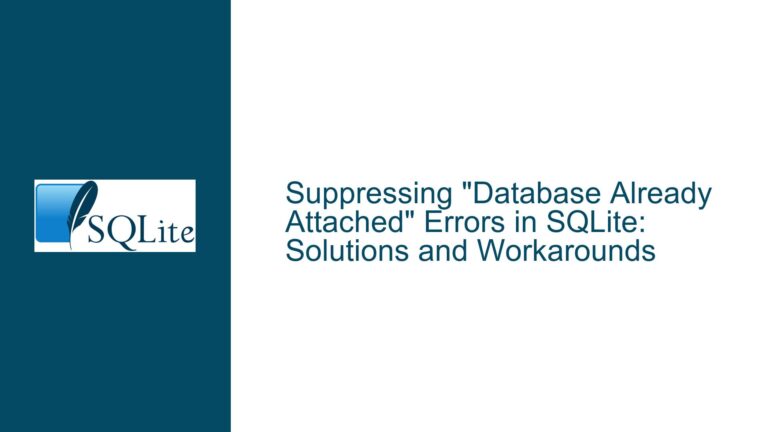Optimizing Multitenant Full Text Search in SQLite with FTS5
Understanding the Multitenant Full Text Search Challenge in SQLite
In a multitenant database architecture, where multiple tenants share the same database but their data must remain isolated, implementing efficient full text search (FTS) can be particularly challenging. The core issue revolves around ensuring that when a tenant performs a search, only their data is scanned and returned, without inadvertently reading or processing data belonging to other tenants. This is crucial for both performance and data privacy reasons.
The scenario involves a table items with a tenant_id column to distinguish between tenants and a text column containing the data to be searched. A virtual table items_fts is created using SQLite’s FTS5 extension to enable full text search capabilities. The initial implementation uses a trigger to automatically update the FTS index whenever new rows are inserted into the items table. However, the search query, while returning the correct results, reads more rows than necessary, indicating that data from other tenants is being scanned during the search process.
The primary concern is that the FTS5 index, by default, does not inherently respect the tenant_id filtering, leading to unnecessary reads. This inefficiency can become significant as the dataset grows, especially in a multitenant environment where the number of tenants and the volume of data per tenant can be substantial.
Exploring the Causes of Inefficient Tenant-Specific Full Text Search
The inefficiency in the tenant-specific full text search arises from the way FTS5 handles indexed columns and how the search query is structured. In the initial setup, the tenant_id column is marked as UNINDEXED, which means it is not included in the full text index. As a result, when a search query is executed, FTS5 scans the entire index for matching text, and only after retrieving the results does it apply the tenant_id filter. This two-step process is what causes the unnecessary reads of rows belonging to other tenants.
Another factor contributing to the inefficiency is the lack of understanding of how FTS5 processes search queries, particularly when it comes to filtering by specific columns. The initial query uses a simple WHERE clause to filter by tenant_id, which, as mentioned, is applied after the full text search. This approach does not leverage the full capabilities of FTS5, which can perform more efficient filtering if the query is structured correctly.
Additionally, the use of GUIDs as tenant identifiers introduces another layer of complexity. GUIDs often contain special characters like hyphens, which can affect how FTS5 tokenizes and indexes the data. If not handled properly, this can lead to suboptimal indexing and search performance, as well as potential issues with false-positive matches.
Implementing Efficient Tenant-Specific Full Text Search with FTS5
To address the inefficiencies in the tenant-specific full text search, several steps can be taken to optimize the FTS5 implementation. The first and most crucial step is to modify the FTS5 table definition to include the tenant_id column in the index. This is achieved by removing the UNINDEXED attribute from the tenant_id column in the items_fts table definition. By doing so, the tenant_id becomes part of the full text index, allowing FTS5 to perform filtering at the index level, rather than after retrieving the results.
The next step involves restructuring the search query to leverage the enhanced indexing. Instead of using a WHERE clause to filter by tenant_id, the query should use the FTS5 syntax to specify the tenant_id directly in the search expression. This approach ensures that the filtering is done during the full text search, significantly reducing the number of rows read. For example, the query SELECT rowid FROM items_fts('tenant_id:69 text:hello'); will only scan the rows that match both the tenant_id and the search term, resulting in a more efficient search process.
When dealing with GUIDs as tenant identifiers, it is important to ensure that they are stored in a format that FTS5 can efficiently index and search. This typically means removing any special characters, such as hyphens, and storing the GUID as a continuous string of hexadecimal digits. This approach ensures that the GUID is treated as a single token by FTS5, reducing the risk of false-positive matches and improving search performance. For example, instead of storing a GUID as 01234567-89ABCDEF-01234567-89ABCDEF, it should be stored as 0123456789ABCDEF0123456789ABCDEF.
Handling user input for search queries also requires careful consideration, especially in a multilingual context. The search input must be processed to ensure that it is correctly tokenized and formatted for FTS5. This involves splitting the input into individual tokens, escaping special characters, and quoting the tokens to ensure that they are treated as separate search terms. For example, if the user inputs hello world, the query should be formatted as SELECT rowid FROM items_fts('tenant_id:69 text:"hello" "world"');. This ensures that the search matches documents containing both "hello" and "world", regardless of their order or position in the text.
In a multilingual environment, the tokenization process becomes more complex, as different languages may have different rules for word boundaries and special characters. It is essential to use a tokenizer that supports the specific languages being used and to preprocess the user input accordingly. This may involve removing or escaping special characters that are not relevant to the search, and ensuring that the input is correctly split into tokens based on the language-specific rules.
Finally, it is important to consider the performance implications of the FTS5 implementation, particularly in a multitenant environment with a large number of tenants and a high volume of data. Regular maintenance tasks, such as optimizing the FTS5 index and monitoring query performance, can help ensure that the search functionality remains efficient and scalable over time. Additionally, testing the implementation with realistic data and query patterns can help identify any potential issues or bottlenecks before they impact the production environment.
In conclusion, optimizing tenant-specific full text search in SQLite with FTS5 requires a combination of careful schema design, query structuring, and input processing. By including the tenant_id in the FTS5 index, restructuring the search queries to leverage the enhanced indexing, and handling user input correctly, it is possible to achieve efficient and accurate search results while minimizing unnecessary reads and ensuring data privacy. With these best practices in place, a multitenant database can provide robust and scalable full text search capabilities that meet the needs of all tenants.






